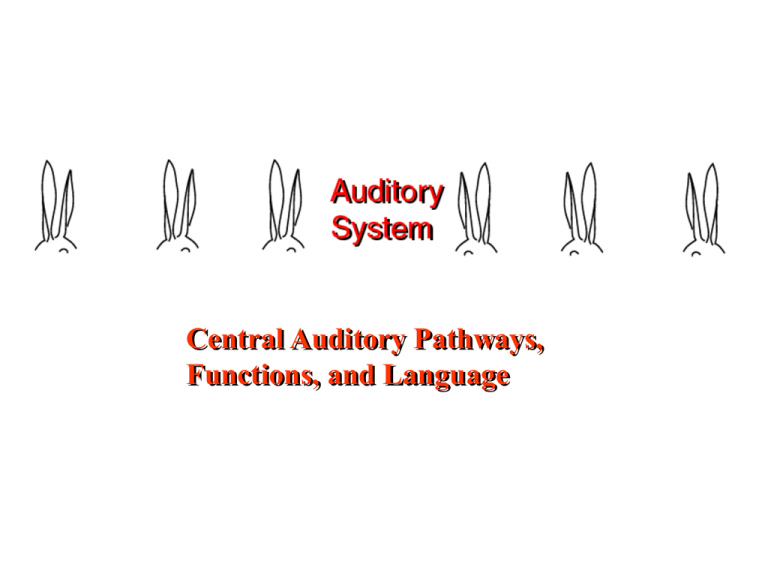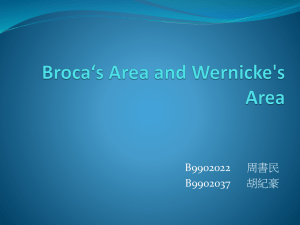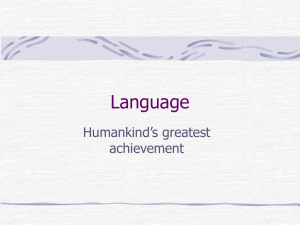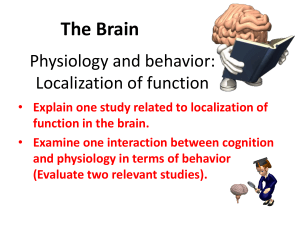Auditory Language & Central Pathways
advertisement

Central Auditory Pathways, Functions, and Language What can we hear? Subcortical auditory pathways 8th nerve (vestibulocochlear) brachium of the inferior colliculus lateral lemniscus Sound Localization Cue 1: Delay between time of sound arrival at left and right ears (speed of sound in air = 342 m/sec) Cue 2: Sound is louder in one ear than the other lateral lemniscus superior olive cochlear nuclei Superior olive, human superior olive “rabbit-ear” neuron in cat MSO axon Stotler 1953 axons from right cochlear nuclei axons from left cochlear nuclei “rabbit-ear” neuron in cat MSO axon Stotler 1953 delay spikes by 250 microsec Do animals with big heads localize sound more accurately? Head size weakly correlated with sound localization precision r = -0.425 Heffner 1997 Density of retinal ganglion cells, 3 species Heffner 1997 Width of high acuity visual field is strongly correlated with sound localization precision r = 0.92 MGN (medial geniculate nucleus) Left hemisphere, cutaway view temporal lobe AI (primary auditory cortex = transverse temporal gyrus) tonotopic map in AI low best frequencies high best frequencies The auditory system is only partially crossed MGN (medial geniculate nucleus) inferior colliculus superior olive cochlear nuclei Primary auditory cortex AI After lesion of AI … Can still identify sounds Can understand speech reasonably well Poor localization of sound in contralateral half of space After lesion of AI … Can still identify sounds Can understand speech reasonably well Poor localization of sound in contralateral half of space Beyond A1…Language areas Beyond A1…Language areas Left hemisphere, cutaway view temporal lobe AI (primary auditory cortex = transverse temporal gyrus) Broca’s aphasia (expressive aphasia): difficulty in speaking or writing Wernicke’s aphasia (receptive aphasia): difficulty in understanding speech or written material Broca’s area lesions Broca’s aphasia (expressive aphasia): difficulty in speaking or writing Wernicke’s aphasia (receptive aphasia): difficulty in understanding speech or written material Wernicke’s area lesions angular gyrus Broca’s area Wernicke’s area Functional imaging studies show a different picture Activating Wernicke’s area in fMRI experiments angular gyrus Broca’s area Wernicke’s area fMRI responses to pure tone task Binder…Prieto, 1997 fMRI responses to language task angular gyrus angular gyrus Broca’s area Wernicke’s area regions activated specifically by listening to words Binder et al. 1997 angular gyrus angular gyrus Broca’s area Wernicke’s area regions activated specifically by listening to words Binder et al. 1997 primary motor cortex angular gyrus premotor cortex Broca’s area Binder et al. 1997 From words to sentences… scrambled sentence: And disappeared the bushes rabbit down the into bounded hill the meaningful sentence: The rabbit bounded down the hill and disappeared into the bushes From words to sentences… scrambled sentence: And disappeared the bushes rabbit down the into bounded hill the meaningful sentence: The rabbit bounded down the hill and disappeared into the bushes Extracting meaning from sentences scrambled sentence: And disappeared the bushes rabbit down the into bounded hill the meaningful sentence: The rabbit bounded down the hill and disappeared into the bushes activity when reading meaningful sentences minus activity when reading scrambled sentences lesions cause problems in naming objects or people (anomic aphasia) Some areas in left hemisphere used in language processing Where are language areas in deaf people who communicate with sign language? Normal subjects, activation by reading “horse”, responding “gallop” Subject #1 Subject #2 Petitto et al. 2000 Normal subjects, activation by reading “horse”, responding “gallop” Subject #1 Subject #2 Petitto et al. 2000 Deaf subjects, view signs for “horse”, respond with signs for “gallop” Petitto et al. 2000 In deaf people who communicate with sign language, Broca’s area helps produce signed speech Deaf subjects: view signs for “horse”, respond with signs for “gallop” Petitto et al. 2000 In deaf people who communicate with sign language, auditory cortex helps out with language processing








